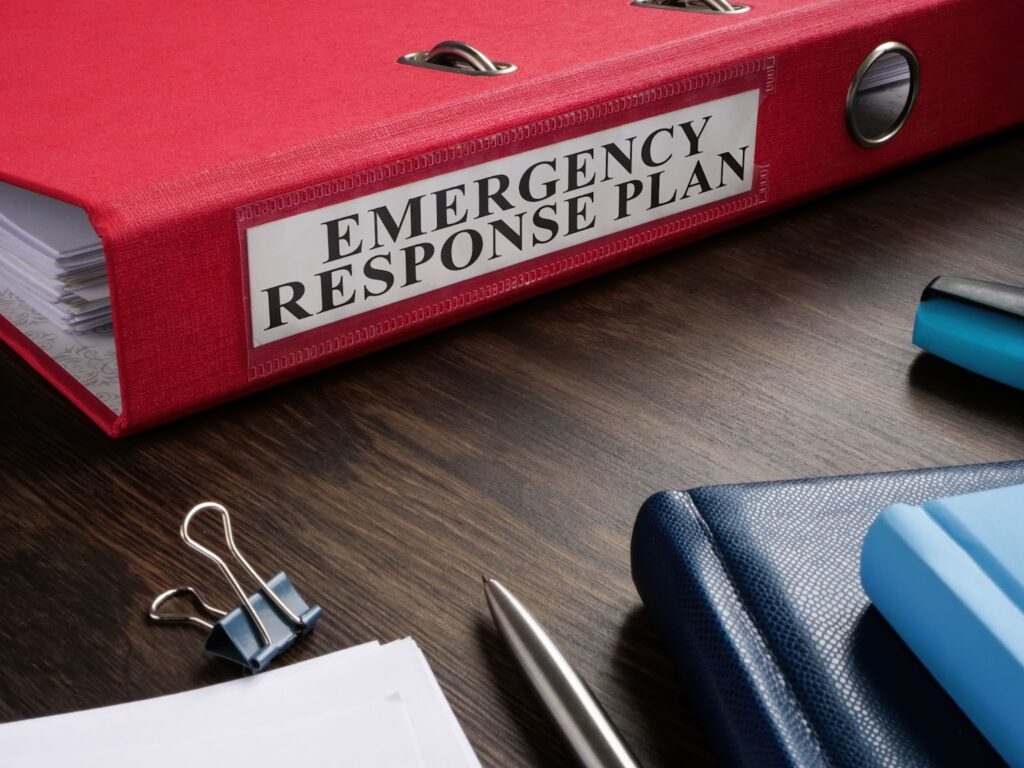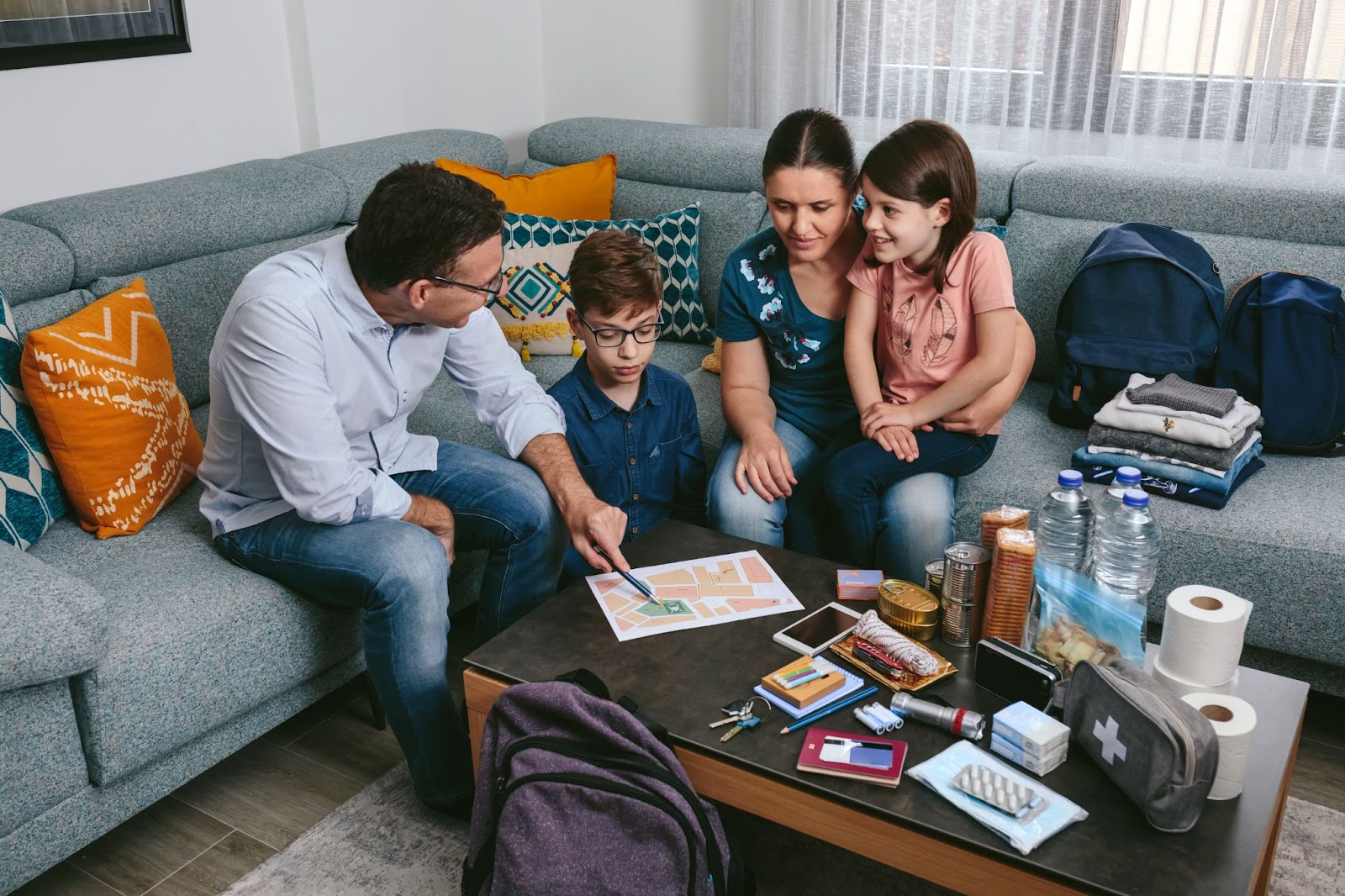Disasters strike suddenly, turning lives upside down. For families, having a comprehensive emergency plan is essential.
Disasters vary widely — from hurricanes to home fires — and understanding their likelihood and impact is crucial for crafting an effective emergency strategy. This safeguards property but, more importantly, ensures the safety and survival of loved ones during crises.
Why is disaster preparedness vital for every family? Disasters often occur with little warning, affecting physical safety and emotional well-being. A well-thought-out family emergency plan provides clarity and reduces panic during such events, helping to protect your family’s health and minimizing disruptions to your daily life.
Understanding risks
Families face various risks depending on their location and situation. From natural disasters like earthquakes and floods to man-made events like power outages and industrial accidents, each scenario demands specific preparations. Discussing and planning for these potential emergencies is crucial to avoid severe consequences.
Benefits of a family emergency plan
Having a plan offers peace of mind, outlining clear escape routes, communication strategies, and emergency meeting points. It includes practical steps like using smoke detectors and maintaining insurance coverage.
Beyond survival, the plan covers essential post-disaster needs such as access to cash, important documents, and additional supplies like toiletries. An effective plan also guides decisions on what to stockpile, like non-perishable food and first aid supplies, and details on securing your home, from manually operating a garage door during a power outage to knowing exit routes.
Creating a comprehensive family emergency plan
Creating a comprehensive family emergency plan is essential for dealing effectively with potential disasters. Start with a family meeting to discuss possible emergencies and agree on response strategies. Everyone needs to know the components of your plan, which should include risk assessments, communication protocols, emergency kits, and detailed evacuation routes.
Assessing potential risks
Identify local hazards by researching regional data from your local emergency management office or the American Red Cross. Consider all risks, including non-geographical ones like house fires.
Establishing communication channels
Set up reliable communication methods for use during a disaster. Designate an out-of-area contact person and ensure all family members know essential contacts and alternative communication methods, such as text messaging or social media. Regularly update and drill your communication plan to ensure effectiveness.
Designating meeting points and safe zones
Identify safe areas both inside and outside your home for various emergencies. Choose locations easily accessible from different places like work, home, and school, and ensure everyone knows how to reach these spots quickly.
Creating a family emergency kit

Assemble a kit with essentials to sustain your family for at least 72 hours. Include food, water, first aid supplies, personal hygiene items, medications, and essential documents. Store this kit in an easily accessible location and make sure everyone in the family knows where it is.
Developing an evacuation plan
Map out primary and secondary exit routes from your home and discuss various evacuation scenarios, including different transportation methods. Regular family drills will help ensure everyone understands how to evacuate quickly and safely.
Educating family members
Continuously educate all family members about potential hazards and emergency procedures. Tailor discussions to be age-appropriate and inclusive, ensuring that children, the elderly, and those with disabilities know what to do and have the necessary support.
Promoting a culture of preparedness
Encourage proactive safety measures at home by assigning responsibilities related to emergency readiness, such as maintaining emergency kits or practicing evacuation routes. Regular family discussions on preparedness help integrate these practices into daily life.
By following these guidelines, your family will be better equipped to handle emergencies confidently and cohesively, ensuring everyone’s safety and minimizing the impact of disasters.
Practice makes perfect: Conducting emergency drills
No plan is complete without practice. This way, you will be able to adjust the plan if you experience unexpected issues. It’s also important for your family to know what to expect if a disaster strikes unexpectedly. Here’s how to maintain readiness:
Regularly testing communication channels
Ensure your family’s emergency communication plan is robust. Regularly check all communication methods, including phone numbers, meeting points, and messaging protocols. Use a “phone tree” system where each member confirms contact with another, and choose a reliable out-of-town contact for emergencies when local systems fail.
Keep your contact lists updated every six months, practice using various communication methods like group texts and battery-operated radios, and ensure everyone knows these protocols well.
Practicing evacuation routes and procedures
Create a detailed home floor plan showing two exits per room to familiarize every family member with multiple evacuation routes. Practice using these exits, operating manual overrides for things like garage doors, and navigating to safe locations under different scenarios, such as during blocked roads or heavy traffic.
Conduct these drills at different times to simulate real emergencies, ensuring tasks are clearly assigned, and essential items like documents and medications are quickly accessible.
Familiarizing family members with first-aid techniques
Equip each family member with first aid skills. Organize training sessions with organizations like the Red Cross to learn CPR, wound care, and how to handle common injuries. Ensure everyone knows how to use the first aid kit and recognize signs of serious health issues like strokes or choking.
Emergency drills should be a routine part of family life, enhancing preparedness and enabling a calm, confident response when disasters occur. Regular practice ensures that everyone knows their role and can help keep the family safe during actual emergencies.
Utilizing technology for enhanced emergency preparedness
In today’s connected world, technology plays a crucial role in enhancing disaster preparedness. Advanced tools enable real-time alerts, emergency updates, and ways to share your safety status with others. Here are some ways to integrate technology into your disaster preparedness strategy:
Mobile apps and online resources
Utilize FEMA and Red Cross apps for localized weather alerts and emergency services access. These apps, social media, and specialized websites offer support, evacuation route updates, and shelter locations. They allow you to:
- Receive immediate weather updates and alerts.
- Access educational resources on emergency preparedness.
- Find nearby emergency services and shelters.
- Connect with neighbors for community support.
Smoke detectors and carbon monoxide alarms
Smoke detectors and carbon monoxide alarms are essential for early warnings. Install them on every floor and inside bedrooms. Test these monthly, replace batteries annually, and fully replace detectors according to manufacturer recommendations to ensure they provide accurate warnings.
Smart home devices
Enhance your preparedness with smart devices that link to your home’s safety systems and provide remote alerts. Smart smoke detectors, security systems, and surge protectors help protect your home and keep you informed, even when you’re away. Ensure these devices are connected to your Wi-Fi, set up for instant notifications, and regularly updated to function correctly.
Adopting these technological solutions significantly improves your home’s readiness for disasters, ensuring you and your family can respond effectively when emergencies occur.
Collaborating with community resources
In disaster situations, collaborating with local resources significantly boosts your family’s preparedness and ability to respond. Leveraging support from utility companies, emergency services, and community centers enhances safety and provides critical resources.
Utility companies
Register for updates to receive timely notifications on outages and safety precautions for utilities like gas, water, and electricity.
Community centers
These often act as vital information points and emergency shelters. Participate in their emergency training sessions to better prepare for disasters.
Cleaning and junk removal services
After a disaster, these services are crucial for cleanup and restoring order, ensuring safe and efficient debris removal.
Emergency management agencies
Engage with local agencies for expert guidance on disaster response. They offer valuable information on potential local threats, community alerts, and emergency plans that consider all family members, including pets and those with special needs. Participate in their drills and use their resources to refine your family’s emergency strategies.
Neighborhood and community groups
Join neighborhood watch programs or community groups to enhance local security and preparedness. These groups facilitate the sharing of timely information and resources, fostering a supportive network that can be invaluable in a crisis.
Supportive networks
Build a network of friends and family to share updates, resources, and support. Establish clear communication plans that include contact details and meeting points, ensuring everyone knows their role in an emergency.
Integrating these community resources into your emergency planning prepares your family for immediate response and aids in recovery and resilience after disasters. Regular interaction with these entities and continuous updates to your plan ensures you are always prepared for the unexpected.

Utah Disaster Cleanup is here for you
For those seeking professional assistance, Utah Disaster Clean Up offers expert services that complement your preparedness efforts.
With our experience in disaster recovery and restoration, we ensure that your property is swiftly and efficiently restored to safety after an emergency. Relying on Utah Disaster Clean Up bolsters your disaster response capability and supports you through the recovery process, allowing you to focus on what matters most — your family’s safety and well-being.
Contact Utah Disaster Cleanup or call 435-512-1584 anytime, 24/7.



